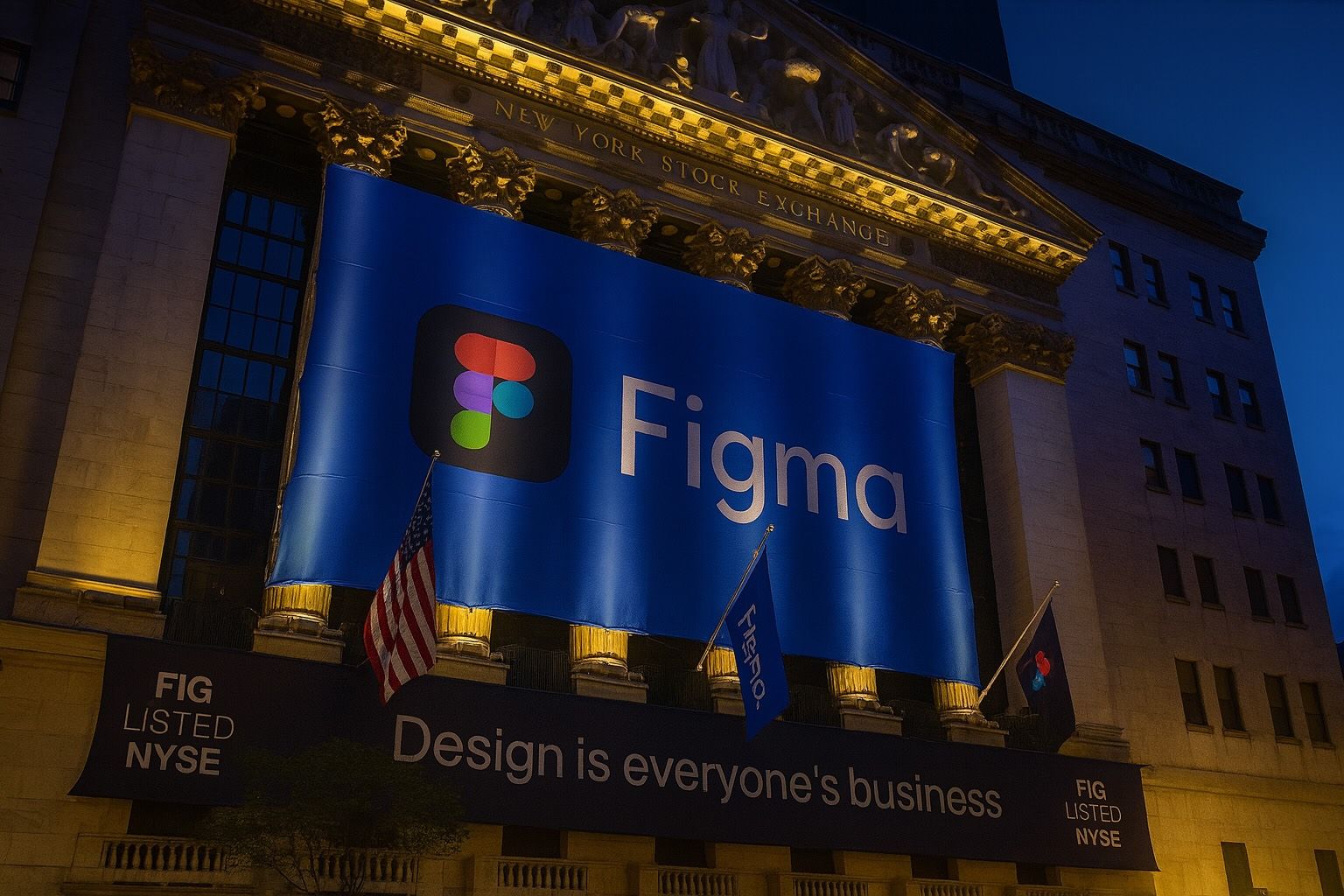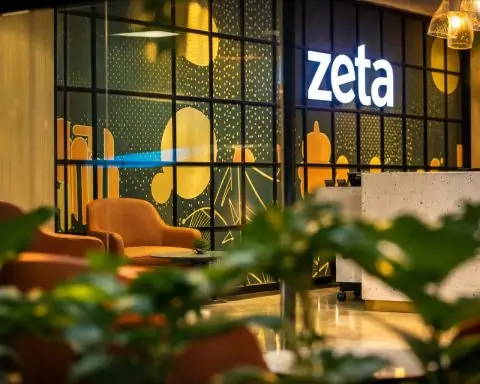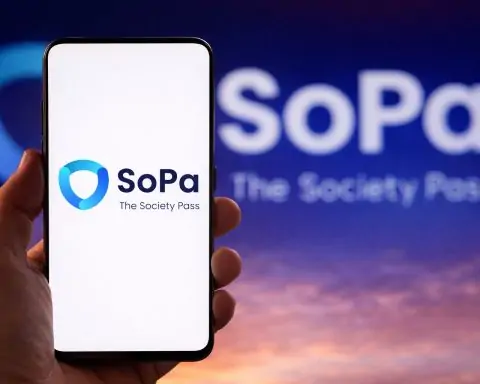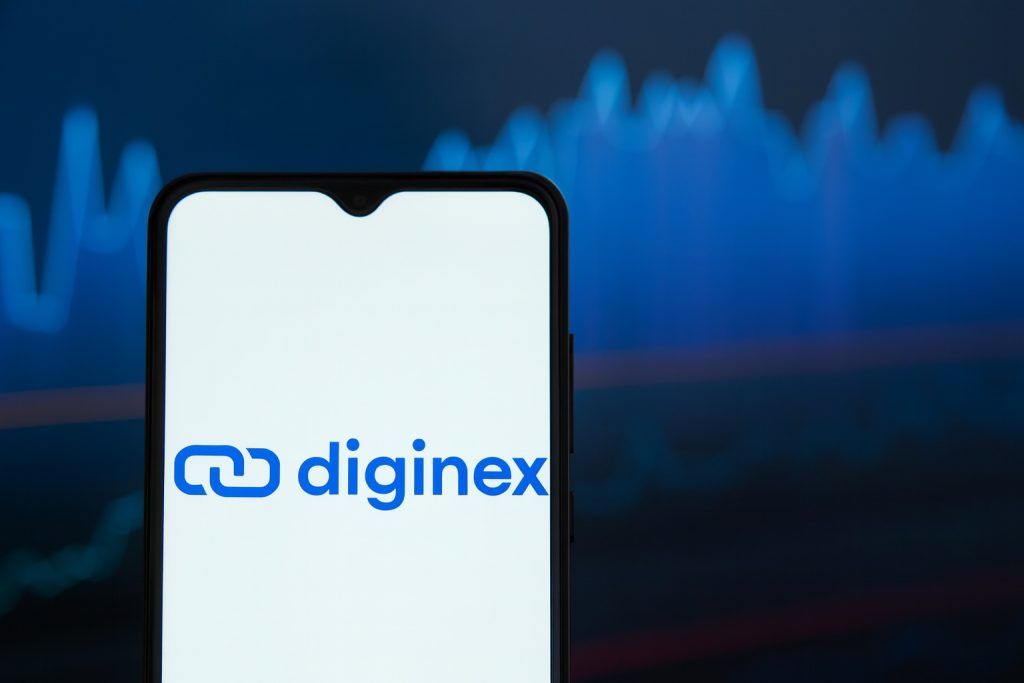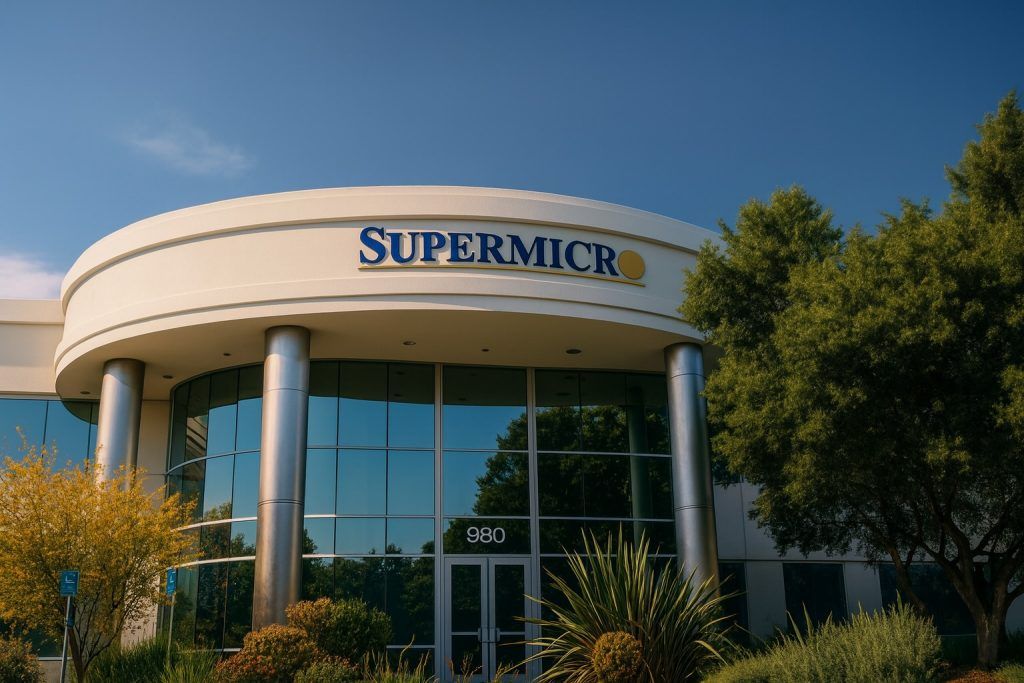- Rollercoaster Debut: Figma, Inc. (NYSE:FIG) saw a spectacular IPO in July 2025, opening at $85 (from a $33 offer price) and soaring to $122 by day two – briefly valuing the design software startup around $68 billion [1]. Those gains evaporated in the ensuing months: FIG plunged over 50% from its peak (–39% in August, –26% in September) before stabilizing around the mid-$50s by early October [2]. Even after this pullback, FIG trades ~80% above its IPO price [3], highlighting extreme post-IPO volatility.
- Latest Rally on AI News: FIG shares jumped ~12% on Oct 6, 2025, after OpenAI’s DevDay showcased a new ChatGPT integration with Figma’s design platform. OpenAI’s CEO demonstrated ChatGPT using Figma to instantly turn a user prompt into a functional design diagram, exciting investors [4] [5]. The stock spiked as much as 16% intraday on the news before closing up about 11–12% around $59 [6], marking FIG’s biggest one-day gain since its IPO.
- Earnings Underwhelm High Hopes: In its first earnings report as a public company (Q2 FY2025), Figma posted 41% revenue growth to $249.6 million (slightly beating estimates) with $0.09 adjusted EPS (vs. $0.08 expected) [7]. Solid as those numbers were, they “fell short of lofty expectations”, and shares sank ~13% after-hours on Sept 3 [8]. Management’s guidance reinforced a growth slowdown – FY2025 revenue is forecast around $1.02 billion (+37% YoY), only a hair above consensus [9]. This implies growth deceleration (Q1 was +46% YoY), a reality check that contributed to FIG’s steep slide in August–September.
- Business Expansion: Figma has aggressively expanded its product lineup and ecosystem. In 2025 alone it launched four new products – notably Figma Make, an AI tool that turns text prompts into app prototypes – along with new tools for illustration, web design, and marketing. This end-to-end design vision was a major IPO selling point and differentiator. The company is also leveraging its hefty cash reserves (>$1.6 billion) for strategic moves: it took a stake in database startup Supabase’s $100M funding round [10] and made small acquisitions (e.g. animation tool Modyfi and CMS platform Payload) to enhance its platform [11]. Figma’s blockbuster debut was even held up by regulators as a win for competition after Adobe’s attempted $20 billion takeover was blocked [12].
- Analyst Outlook: Wall Street’s stance on FIG is cautious. Of 10 analysts covering Figma, 7 rate it “Hold” and 3 “Buy,” with a median 12-month price target ~$67 (roughly 15% above current levels) [13]. Following the post-IPO plunge, several banks slashed their targets into the mid-$60s – e.g. Morgan Stanley cut its FIG target from $80 to $70, citing a more realistic growth trajectory [14]. Bulls argue Figma’s fundamentals remain strong (41% growth, 129% net retention, positive margins) and see the recent sell-off as a “buying opportunity” for a high-quality franchise [15]. But skeptics warn that even after a 55% drop, FIG still trades around 25× forward sales, and its slowing growth (now partly driven by price hikes) may not justify such a premium [16] [17]. In short, expectations have reset, and Figma now must prove it can grow into its valuation.
Stock Performance & Market Activity
Figma’s stock has experienced extreme swings since its July 2025 IPO. The IPO itself was euphoric – priced at $33 per share, FIG opened at $85 and shot up to $122 within two days [18]. This ~270% surge reflected intense optimism for Figma’s collaborative design software and came amid an upbeat tech IPO market. Even U.S. regulators took note: FTC Chair Lina Khan highlighted Figma’s $68 billion first-day valuation as validation for blocking Adobe’s bid, seeing Figma as a thriving independent competitor [19].
However, gravity hit quickly. After the debut frenzy, investors reassessed Figma’s frothy valuation (which exceeded 200× forward earnings at the peak [20]). FIG shares plummeted 39% in August and another 26% in September [21], erasing most of the initial pop. By the end of Q3, the stock was about 60% below its high. Notably, this slide happened even as broader markets rose (~+3% for the S&P 500 in Aug–Sep), underscoring that Figma’s drop was driven by company-specific expectations reset [22] rather than a market downturn.
Entering October, FIG finally showed signs of finding a floor. The stock closed at $53.04 on Oct 3 [23] then bounced in early October, trading back into the high-$50s. On October 6, Figma staged a sharp relief rally, climbing from the low-$50s into the $60+ range intraday. This double-digit surge was fueled by a high-profile AI catalyst: OpenAI’s DevDay event unveiled that ChatGPT can now integrate directly with Figma’s design tools. In a live demo, OpenAI’s CEO Sam Altman asked ChatGPT to generate a product diagram, and ChatGPT invoked Figma to instantly produce a functional design – showcasing a powerful new use-case for Figma [24] [25]. Investors cheered the exposure and potential user growth from this integration. FIG stock jumped over 10%+ on Oct 6 (peaking ~16% intraday) on heavy volume, marking its biggest single-day gain since the IPO [26]. It closed around $59, still ~50% below its July high, but about 60% above the IPO price. Year-to-date (essentially since IPO), FIG remains up roughly 60% from $33 [27] – cold comfort for anyone who bought at $100+, but a reminder that early IPO backers are still in the green. Volatility is likely to persist as the young stock continues to find its post-hype equilibrium.
Recent News & Catalysts (Early October 2025)
Outside of the stock’s wild price swings, news flow around Figma in early October has been focused on its technology integrations and investor sentiment. The standout catalyst was the Oct 6 ChatGPT integration announcement discussed above. OpenAI’s introduction of third-party “apps” within ChatGPT (including Figma’s plugin) not only gave FIG a market boost, but also reinforced Figma’s strategy of infusing AI into design workflows. Figma’s own blog detailed how users can now turn ChatGPT conversations into FigJam diagrams automatically [28], underlining the company’s push to weave generative AI into its platform. This development positions Figma to leverage the broader AI momentum in tech – a positive signal as investors increasingly favor companies with an AI story.
Apart from the AI buzz, the company itself has been relatively quiet news-wise in recent days, due in part to the customary post-earnings quiet period [29]. There have been no major new product announcements or leadership changes since the IPO rush of summer 2025. One notable tidbit: Figma’s 33-year-old CEO Dylan Field has downplayed the stock’s volatility internally, telling his team to ignore short-term price swings and focus on “the inputs” they can control (product and user success) [30]. This anecdote, shared in a late September interview, reflects management’s long-term orientation amid the rollercoaster market debut. It also echoes how other visionary founders handle volatile valuations – by keeping employees focused on product innovation rather than daily ticker quotes.
Another factor that briefly drew attention was the expiry of certain IPO lock-up restrictions. According to Reuters, because FIG’s stock held up above certain thresholds, some employee share lock-ups ended earlier than initially scheduled [31]. Indeed, regulatory filings showed large shareholders (like early investor Daniel Rimer of Index Ventures and funds like Kleiner Perkins) took advantage of early August trading windows to trim their stakes, unloading millions of shares around ~$31–32 in early August [32]. These insider sales (totaling ~19.6 million shares sold last quarter [33]) added transient selling pressure on FIG. While such sales often spook retail investors, they were likely motivated by venture funds securing returns after the IPO pop, and the prices were well below current levels. Going forward, with lock-ups largely past, the market’s focus will shift back to Figma’s execution and fundamentals rather than technical share supply events.
Business Developments & Strategy
Figma’s core business thesis – to become the all-in-one collaboration platform for design and product teams – has been on full display in 2025. The company used the run-up to its IPO to showcase a flurry of new products that extend its reach beyond its flagship design tool. In 2025 alone, Figma “doubled its product lineup”, launching four new tools across the product design lifecycle. Among these is Figma Make, an AI-powered module that can transform a text prompt into a working app prototype. Make debuted to much fanfare as it leverages generative AI to automate design mockups – a feature that resonated with investors chasing AI-enabled growth. Other additions like Figma Draw (digital illustration), Figma Sites (web publishing), and Figma Buzz (marketing design) further signal Figma’s ambition to cover “every aspect of product development – from ideation to coding and shipping” within its ecosystem [34]. This aggressive innovation pipeline was a key reason for the lofty valuations: it painted Figma not just as a single app, but as a platform play poised to capture a greater share of the design and development process.
To support this vision, Figma has been investing heavily in R&D (reflected in its 90% gross margins and still modest profitability) and even engaging in strategic deals. Notably, Figma has begun to forge partnerships and make venture investments to bolster its platform. In a recent example, Figma participated as a new strategic investor in Supabase, an open-source backend-as-a-service startup, contributing to Supabase’s $100+ million Series E round [35]. The synergy makes sense: Supabase’s tools could complement Figma’s efforts (e.g. integrating databases with Figma’s developer hand-off features in “Dev Mode”). Such an investment suggests Figma is looking to strengthen its appeal to the developer community and perhaps ensure that designs created in Figma can more seamlessly turn into running applications (an area where having backend infrastructure know-how helps).
Additionally, Figma hasn’t shied away from M&A. In Q2, it quietly acquired two small companies – an animation design tool named Modyfi and a content management startup Payload [36]. These tuck-in acquisitions are aimed at enriching Figma’s capabilities (animation, and tying design to content/code) as it builds out a one-stop design-to-development platform. With over $1.6 billion in cash on hand post-IPO [37], Figma has plenty of dry powder to continue such strategic bolt-ons or even larger acquisitions, if opportunities arise.
It’s worth noting that Figma’s independence was hard-won. Adobe’s attempted $20 billion takeover of Figma in 2022–2023 was terminated after global regulators signaled strong opposition on antitrust grounds. The blocked Adobe deal set the stage for Figma’s IPO: rather than become part of Adobe, Figma is now directly competing with the design behemoth. Regulators like the FTC’s Lina Khan effectively cheered Figma’s successful IPO as a validation of their intervention [38]. For Figma, this means the company must justify that faith by continuing to innovate faster than the likes of Adobe XD and other rivals. The upside is that Figma now controls its own destiny with a fresh war chest and public stock currency; the challenge is fending off a motivated Adobe (and others like Sketch or emerging players) in a fast-evolving space. So far, Figma’s move to broaden its offerings and embrace developers and AI suggests it is gearing up for that fight.
Analyst Commentary & Forecasts
Wall Street analysts and industry observers have been dissecting Figma’s post-IPO trajectory with a mix of awe and apprehension. Early on, Figma was trading on narrative and promise – at one point over 65× forward sales by some estimates [39] – which left little room for error. As Michael Ashley Schulman of Running Point Capital quipped, “The stock had been priced for perfection at over two hundred times expected earnings, [so] even solid numbers cannot carry that many layers without some flattening.” [40]. (The design pun about “layers” was not lost on anyone.) In other words, Figma’s valuation was so stretched that anything short of blowout performance would trigger a reality check – which is exactly what happened when Q2 results came in merely good, not miraculous. “Figma’s high valuation was built on [future] story and potential, and management’s outlook disappointed,” Schulman noted of the September sell-off [41].
Since then, analysts have tempered their forecasts. The consensus 12-month price target is in the upper-$60s (around $67–70) [42] [43], which suggests modest upside from current prices – a far cry from the $100+ levels FIG briefly touched in July. Price target ranges are wide, from optimistic highs in the mid-$80s to pessimistic lows in the upper-$40s [44], reflecting uncertainty about Figma’s sustainable growth rate and competitive moat. Importantly, most analysts are sitting on the fence with a Hold rating. MarketBeat data shows roughly 3 Buys vs 7 Holds, and no prominent firm advising a sell at this stage [45]. This skew toward Hold/Neutral ratings often happens when a hot IPO cools off – analysts acknowledge Figma’s strong product and growth, but want to see more execution before recommending it as a buy at its still-rich valuation.
Growth projections remain upbeat but realistic. Figma itself guided to ~33% YoY revenue growth for Q3 2025 and ~37% for the full year [46], which implies continued deceleration into Q4. While 30–40% growth is impressive for a company nearing $1 billion in annual revenue, it’s markedly lower than the 50%+ rates Figma sustained pre-IPO. Some analysts worry that a chunk of Figma’s recent growth has come from raising prices or upselling existing customers (contributing to a stellar 129% net dollar retention rate) rather than pure new customer expansion [47]. As Motley Fool’s Jon Quast observed, “much of the growth it’s projecting comes from charging higher prices,” a lever that can’t be pulled too often without risking customer churn [48]. This puts pressure on Figma to keep expanding its user base (especially enterprise clients) and to monetize new products like Make or Dev Mode, rather than leaning repeatedly on price increases for the same user cohort.
Bull vs. Bear case: Bulls point out that Figma still has a lot going for it: a beloved product with viral adoption, high-margin SaaS economics, and a large market to penetrate (every company building digital products needs design/collaboration tools). They note that Figma managed to post a GAAP profit (1% operating margin) in Q2 [49]– a rarity for a recent tech IPO – showing admirable cost discipline even as it grows. A Seeking Alpha commentator even argued the post-IPO plunge is an opportunity, given Figma’s “positive business fundamentals” (strong growth, retention, and cash flow) and long runway in a digital-first world [50]. From this view, as long as Figma executes well – continuing to innovate in AI and cross-functional collaboration – the stock could recover once growth re-accelerates or profit scales up.
Bears, on the other hand, emphasize valuation and competition. Even after falling by half, Figma trades at over 25× forward sales [51], a premium reserved for top-tier software names. If growth settles in the 30% range and edges down further next year, that multiple could still be hard to justify, especially in an environment where investors can find cheaper growth elsewhere. Larger rivals like Adobe are not standing still – Adobe XD and other Creative Cloud tools could incorporate similar collaboration features or aggressive pricing to defend their turf. New challengers (including open-source or AI-native design tools) also loom on the horizon. Skeptics thus see FIG as vulnerable: a great product, yes, but perhaps priced for perfection in a space where competition will inevitably squeeze margins or slow Figma’s client wins. For now, the average analyst rating is “Hold” [52], which encapsulates this balanced view – essentially a wait-and-see stance on whether Figma can defy the doubters.
Outlook and Sector Context
Figma’s journey in 2025 encapsulates the rebirth of tech IPOs – and the market’s fickle nature. After a dry spell in 2022–2023, investors were eager to embrace a high-growth story like Figma, especially given its narrative (design collaboration + AI) and the high-profile drama of Adobe’s failed acquisition. The initial pop and subsequent flop of FIG stock is a reminder that even in a bullish market, fundamentals eventually matter. The broader tech sector has been mostly strong (the S&P 500 and Dow hit record highs in October 2025 despite macro headwinds [53]), and risk appetite for growth stocks is returning as interest rate hikes pause. But as Figma’s case shows, the market is now rewarding sustainable growth and profitability over hype. Companies that can demonstrate both solid top-line expansion and a credible path to profits tend to fare better once the IPO adrenaline wears off.
For Figma, the next few quarters will be crucial. The company is slated to report Q3 and Q4 results in late 2025, which will be closely watched to see if growth stabilizes in the 30%+ range (or surprises to the upside) and if margins improve. Execution on its new products and features – such as converting the buzz around Figma Make and the ChatGPT integration into actual user adoption and revenue – will be key in regaining investor confidence. Figma’s leadership has the cash and talent to continue innovating aggressively, which they’ll need to do as rivals adapt. The good news is that Figma operates in a huge and expanding market (digital product design/collaboration) with secular tailwinds. The challenge will be living up to the sky-high expectations that come with a premium valuation.
In the wider context, Figma’s post-IPO saga also highlights a shifting dynamic in tech: regulators are more skeptical of Big Tech takeovers, meaning standout startups like Figma are more likely to remain independent and go public rather than get acquired. That puts the onus on these companies to scale on their own. Figma has so far shown it can attract big customers (its software is used at companies like Netflix, Uber, and Airbnb) and maintain strong retention. If it can navigate the next phase – balancing growth with profitability, expanding its platform, and defending its turf – there is a path for FIG stock to recover in the long term. Analysts’ current forecasts of mid-teens upside over 12 months [54]could prove conservative if Figma re-accelerates, but conversely, any stumbles could keep the stock subdued.
In summary, Figma, Inc. stands at a post-IPO crossroads. The initial euphoria around FIG has given way to a more sober assessment: the company’s vision of an all-in-one design platform powered by collaboration and AI is compelling, but now it must execute under Wall Street’s watchful eye. The recent AI integration news shows Figma can still capture the market’s imagination, but sustaining that momentum will require delivering financial results that match the product excitement. As 2025 winds down, investors in FIG will be looking for proof that Figma can translate its design-world dominance into durable growth – and perhaps eventually justify the bold $68 billion valuation it commanded on day one. The honeymoon may be over, but Figma’s real marriage with the public markets has just begun, with plenty of chapters yet to be written. [55] [56]
Sources: TS2 Tech [57] [58]; Reuters [59] [60]; MarketScreener [61] [62]; MarketBeat [63] [64]; Figma Blog [65]; Motley Fool via Nasdaq [66]; Figma Investor Relations [67] [68].
References
1. ts2.tech, 2. ts2.tech, 3. ts2.tech, 4. www.marketscreener.com, 5. www.marketscreener.com, 6. www.marketscreener.com, 7. ts2.tech, 8. ts2.tech, 9. ts2.tech, 10. ts2.tech, 11. ts2.tech, 12. ts2.tech, 13. ts2.tech, 14. www.marketbeat.com, 15. ts2.tech, 16. ts2.tech, 17. ts2.tech, 18. ts2.tech, 19. ts2.tech, 20. ts2.tech, 21. ts2.tech, 22. ts2.tech, 23. ts2.tech, 24. www.marketscreener.com, 25. www.marketscreener.com, 26. www.marketscreener.com, 27. ts2.tech, 28. www.figma.com, 29. ts2.tech, 30. ts2.tech, 31. www.reuters.com, 32. www.marketbeat.com, 33. www.marketbeat.com, 34. ts2.tech, 35. ts2.tech, 36. ts2.tech, 37. ts2.tech, 38. ts2.tech, 39. ts2.tech, 40. www.reuters.com, 41. www.reuters.com, 42. ts2.tech, 43. www.marketbeat.com, 44. ts2.tech, 45. www.marketbeat.com, 46. ts2.tech, 47. ts2.tech, 48. ts2.tech, 49. ts2.tech, 50. ts2.tech, 51. ts2.tech, 52. www.marketbeat.com, 53. ts2.tech, 54. ts2.tech, 55. ts2.tech, 56. ts2.tech, 57. ts2.tech, 58. ts2.tech, 59. www.reuters.com, 60. ts2.tech, 61. www.marketscreener.com, 62. www.marketscreener.com, 63. www.marketbeat.com, 64. www.marketbeat.com, 65. www.figma.com, 66. ts2.tech, 67. ts2.tech, 68. ts2.tech
